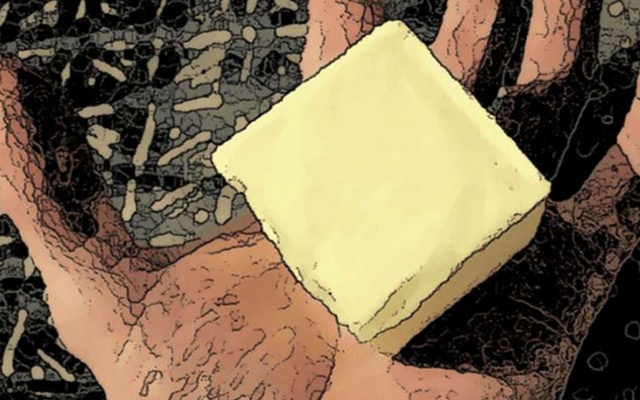There are good reasons to maintain that the year 2003 was the year when the long-heralded network society was finally born. Between the enthusiastic gestation period of the 1990s cut short by the dot-com crash in 2001 and the eruption of social media onwards, there was a short but restless period when all kinds of phenomena – technological, social, and political – were finally shedding any and all doubts about the networked future. It wasn’t just the year when social networking sites such as Friendster, MySpace, LinkedIn, or del.icio.us were launched. Google released its AdSense, Second Life opened its virtual worlds, and Skype introduced peer-to-peer video conferencing. Before the presidential candidate Howard Dean lost the Democratic nomination to John Kerry, he had drawn a lot of attention by pioneering the way the internet is now used in political campaigns. There was the US invasion of Iraq coming and to this day, the 15th of March anti-war protests are considered to be “the largest protest event in human history.” In that very same year, Duncan J. Watts with colleagues published the results of the email experiment designed to verify the classic Milgram’s small-world hypothesis that suggested that on average everyone is socially linked to everyone else by six people. Also, Albert Lászlo-Barabási, one of the central figures of the new “science of networks” publishes his immensely popular Linked and the aforementioned Watts re-publishes his Six Degrees from 2002 with an added chapter because “the year 2003 (..) has been something of a poster child for the connected age.”1 Of course, not many of these events have become part of the living memory; their meaning lies rather in being symptoms of the network culture that remained merely assumed until it reached critical mass. And short-lived as they were, in the midst of this flutter there shined something peculiar, a glint of a phenomenon called, quite appropriately, flash mobs.
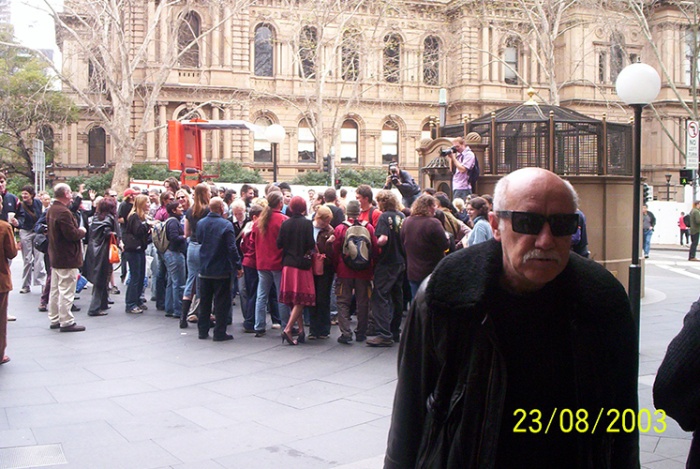
Sydmob, pierwszy flash mob w Sydney (Australia), 23.08.2003 r. Zdjęcie: Surturz, wikimedia commons. CC BY-SA 3.0
From the point of view of passers-by, a flash mob is a sudden and unexpected gathering of a group of people, typically in a public space who for a very short time do something unusual, like gathering around a rug, doing a weird dance, shouting something inconsequential, and then disperse just as quickly. It is believed that the first flash mob took place in New York in the summer of 2003, immediately followed by a number of flash mobs around the whole world. And although they kept appearing here and there a long while after that, it is largely maintained that it died out as fast is it appeared. Of course, there are precursors, both explicit and implicit, appearing mostly during the social revolutions of the 1960s, be it street theater, the Situationist movement, or happenings. Meaning, what appeared first as a prophetic emancipatory gesture of avant-garde art, gets repeated a few decades later in the emerging network culture as a mere frill on the new political economy of attention. First as tragedy, then as farce, one might say, surely, but there is a deeper explanation of the phenomenon, and I’d like to draw some conclusions from one specific example of flash mobs that incidentally originated in Czechia and even pre-dated the American ones.
At 6 p.m. on 10 October 2002, a group of people gathered in front of the McDonald’s on Vodičkova street in Prague and simultaneously in front of the same franchise on Freedom Square in Brno.2 Invited through various alternative and nerd websites3 and instructed to merely observe what was taking place inside, the participants (or sheep as goes the lingo) dispersed after 15 minutes to the puzzlement of all who witnessed the strange and even scary gathering (especially the ones eating hamburgers inside). Although it matched all the criteria of a flash mob, according to the organizers known only as Máslo (Butter), this wasn’t a flash mob. This was a Reality Hack.
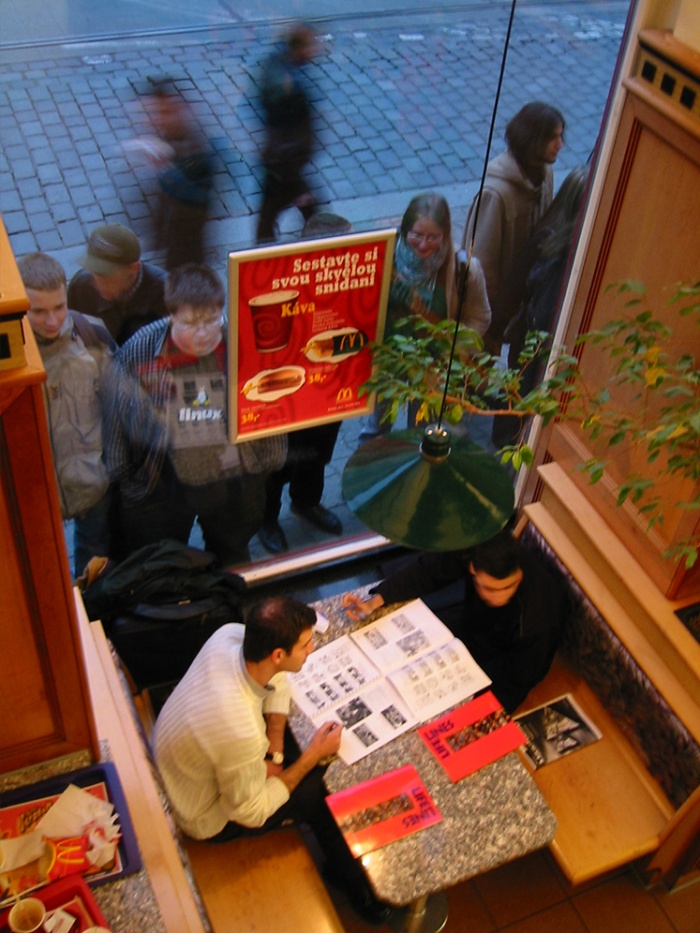
Hakowanie rzeczywistości [Reality Hack], flash mob zorganizowany przez grupę Máslo w Pradze,10.10.2002 r. Zdjęcie: dzięki uprzejmości grupy Máslo.
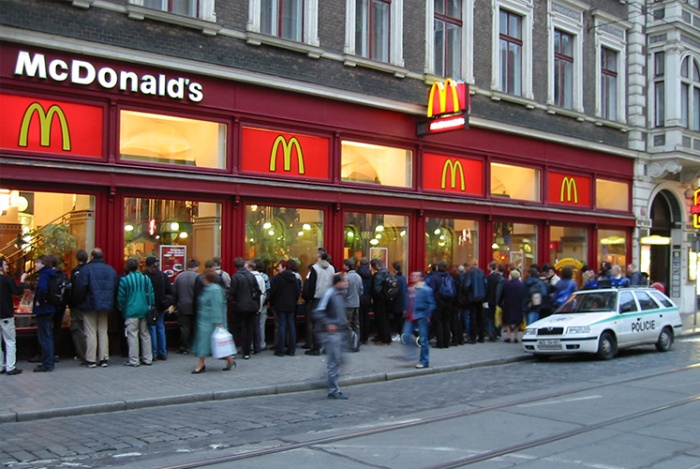
Hakowanie rzeczywistości [Reality Hack], flash mob zorganizowany przez grupę Máslo w Pradze,10.10.2002 r. Zdjęcie: dzięki uprzejmości grupy Máslo.
Let me explain. Now, it would be a gross mistake to explain the flash mobs solely by the new possibilities offered by ripened network technologies. There were wider forces at play. And not least of them was… let’s call it the mood of the times – the feeling of something new. But not that something new was yet to come. Quite the contrary, it was the blurry but unsettling realization that it had already been there, something fundamental and that we were only to find out what and also that it was already too late to do anything about it. The source of this paranoid feeling was dubbed Máslo.4
Where did Máslo come from? Back then, not unlike today, the world was changing fast, but all in all, the times weren’t as charged with politics. At least not in the minds of the coming generation. If the '90s were marked by settling into the new world order, one of globalization, then the onset of the new century was met with a new phase of cultural reactions to the unceasing, unslowing process of mediatization catalyzed further by the developments of digital technologies. The internet was starting quite ostensibly to take hold of the society as there probably wasn’t a more virile idea than connectedness back then. The notion of distance being rapidly transformed beyond recognition, the awe of the small world hypothesis,5 the newly emerging many-to-many communication model6 captured the imagination of… well, many. If Jaromír Volek, a Czech media sociologist, was right about the communication in itself becoming a social virtue,7 this was probably its heyday, before the media got infected by fake news.
The critical awareness of globalization and McDonaldization was still there but it was further elaborated into culture jamming utilizing the methods of tactical media when the artists and activists were hijacking the visual identities of corporations in order to criticize them. The feeling that not just the world but reality itself was inescapably being enclosed by the invisible and ruthless hand of the global market was ever-present. It seemed like the images of corporate fascism as envisioned by the cyberculture of the 1980s and '90s were becoming real together with the concept of “meatspace” as the lower-level reality left over to the working classes.8 The threat of the Y2K bug failed to materialize but the magnitude of the expected troubles suggested how far and how deep digital technology had already reached. What was at stake back then? A reasonable person might have said: the world as we know it; for a paranoid person, it would add up to the already growing suspicion of reality itself. Furthermore, on the heels of the spectacularly misunderstood Baudrillard and his ideas about hyperreality, the recent and very influential movies like Fight Club and Matrix were turning this crawling suspicion into something cool and enjoyable with the cherry on top being the persistent reports of mad cow disease. The web diary on the Máslo website9 from 25 June 2002, reads: “The problem today is not how to make a living. The problem is how not to go crazy.” And as the paranoia long before sensed and captured by Thomas Pynchon’s novels was becoming ubiquitous, a small, anonymous group of young people in Czechia enacted a commentary on the situation, a playful move in the game of reality perceived to be rigged so deeply only a joyful hack can face it properly. So if the flash mobs can be considered a short-lived but significant cultural symptom of the newly born network culture, Máslo followed an even deeper, more paranoid ambition10 though with all the more playfulness – it set itself no minor goal as it aimed to hack reality itself.
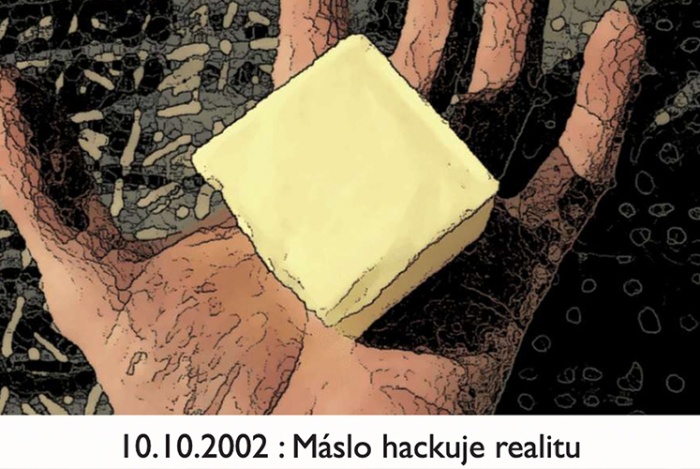
10.10.2002: Máslo hakuje rzeczywistość. Źródło: grupa Máslo.
As I later found outin 2003, in a quite adventurous investigative fashion,11 Máslo was primarily two people, a journalism student from Brno and a programmer from Prague, surrounded by a small, more or less participatory group of friends. On the website maslo.cz, they identified themselves with email-ready pseudonyms such as osvicene@maslo (enlightened@butter) and opravdove@maslo (true@butter). So why Máslo, i.e. Butter? The name was a product of what can be formally characterized as the primal paranoid experience: initially, the notion of butter came from a joke that turned into a privately shared phrase consequently shed of any context, then it became a switchword that popped up all the more frequently since the word “butter” is so common. And when you infuse such a common word with a private significance, you soon start to see it everywhere.12 Enter paranoia.
But again, this was a cultural paranoia, not a psychotic one. It was like a genre, a type of discourse, produced as an appropriation of the historical mood. This logic is immediately clear from the Máslo’s very first Reality Hack:13 a website that copied the visual identity of the Slovak hacking group binary.division, rebranded as buttery.division and propounding a blunt paranoia in language much similar to the one used in texts binary.division had often left on the websites they hacked. In effect, it looked like the Máslo website had been hacked by binary.division. Elsewhere and with a much more pronounced target, such as a corporation or global brand, this would be a clear case of culture jamming – subversively appropriating its visual identity. But the binary division was no figure of globalization worthy of culture jamming; if anything they were the culture jammers, famously targeting public mail servers, websites of newspapers, the Czech Police or the Ministry of Interior.14 The very simple HTML site was originally meant as a gesture of admiration of the hacker’s group. An admiration so honest that it could be expressed only by affirming the logic of hacking. The confusion this website sewed in the community wasn’t expected but it certainly was appreciated.15 The binary.division, too, spread the conspiratorially paranoid messages (“you live with the impression of false security and you refuse to believe it is just an illusion”),16 but what Máslo achieved with this website was paranoia squared. They hacked the image of hackers. As everyday life was slowly merging everywhere with its media representation, reality and fiction were becoming indiscernible and inseparable. Máslo’s first Reality Hack provided a mischievous glimpse into what was eventually to be called “the business of perception.”17
The success of this “hack” incited a move into the “meatspace.” The instructions spread through discussion boards and a bunch of willing websites (see note 2) were clear. The participants were to come to the McDonald’s (in Prague or in Brno), and stand without any proclamation or explaining for 15 minutes looking inside and then disperse. To add a conspiratorial wink to the already mysterious message, the invitation hinted: “You don’t know why you should participate? Then don’t come. You do? Good then.”18 Drawing the attention of the media19 and police, the aura of the event got seasoned with confusion about its meaning.20 Read: a huge success.
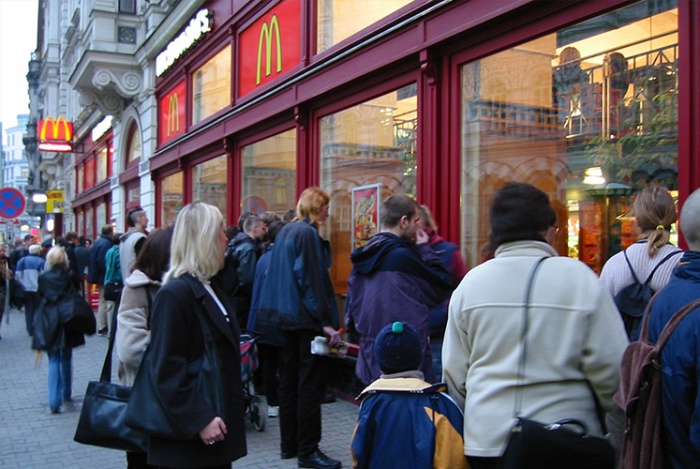
Hakowanie rzeczywistości [Reality Hack], flash mob zorganizowany przez grupę Máslo w 2002 r. Zdjęcie: dzięki uprzejmości grupy Máslo.
Fun fact: Five days after this Reality Hack, Howard Rheingold published his Smart Mobs: The Next Social Revolution where he introduced the notion of “smart mobs” that “consist of people who are able to act in concert even if they don’t know each other.”21 So as you can see, that time almost mythologizes itself, since such coincidences abound.
Now, from the very beginning, the original founders of Máslo were smart about the potential of such actions. Almost too smart, as the very first entry of Máslo website diary from 22 May 2002, begins with the words “And that is how it usually ends...”22 Being there when the blogosphere as a new kind of publishing was about to turn mainstream, the people involved with Máslo recognized how fast an internet phenomenon such as blogs could deteriorate. Similarly, Máslo anticipated the rapid loss of any spark their actions carried. This was proven half a year later, when Máslo announced the third and last Reality Hack for 25 June 2003.23 Its goal was, once again, to bring together as many people willing to hack reality as possible. This time, however, they were to befuddle the passers-by by handing out small change (1 CZK) provided the receiver just sign a simple takeover declaration. And even though participation was welcomed and expected in more cities than the last time, the turnout was so low that afterwards, Máslo never initiated any more public events and continued its existence solely in the form of its smart-ass website diary. Which is not to say they ceased to draw attention.
Mind you, all three Reality Hacks took place before the supposedly first flash mob in NY. So as soon as the consequent summer of flash mobs24 took place, the event that took place in front of McDonald’s was seen as a flash mob avant la lettre, drawing the attention of the techno-optimistic flagship of network culture, Wired magazine. In their reaction to this renewed interest, Máslo vehemently denied that the Reality Hacks were flash mobs,25 even though the second one, they admitted, met all the characteristics.26 “Reality can be hacked in many ways.”27 Seeing how the flash mobs were fast becoming not just different to the reality hacks but their stark opposite as with their growing popularity in Czechia they were actually becoming mundane and boring and generally swallowed up by their own success. This happened even faster in America when Time reported that “Participants are worried that they'll soon be outnumbered by reporters.”28
So do these stunts actually merit being called hacks even though there were no actual computers being hacked? Isn’t it just a fancy metaphor? I don’t think so. It just shows how the computer truly is the machine of our times as its transposes itself onto wider cultural logic. It parallels and further catalyzes the intensive and extensive social reflexivity of the 20th century with its recursive nature as the whole of the computer functions as its own parts. And what the actual hackers do is they take advantage of the misalignments of its self-referential nature. As Slavoj Žižek points out, in this way the inconsistencies of the computer are in themselves consistent, enabling the existence of a hacker culture whose only goal is to “exploit the fault, the symptom of the system.”29 While “excluding themselves from everyday normality,” its bureaucracy and instrumentality, they manifest their prowess and moral disgruntlement with new, mediatized, globalized world with inscrutable masters, and thus become ninja-like Robin Hoods, as the cliché goes. With Máslo, this logic of hacking spilt into the streets, leaving the normal people befuddled and the followers in awe. Because as the computer technologies with their totalizing effect weaved a new kind of reality, hacking just had to be elevated along with it. Acting on the impulse embodied most generally by the flash mob phenomenon, Máslo embodied a bottom-up cultural desire to break the fourth wall of what was felt like a total mediatic enclosure. As one early bored critic of flash mobs remarked: “How much more meta can it get? None. None more meta.”30
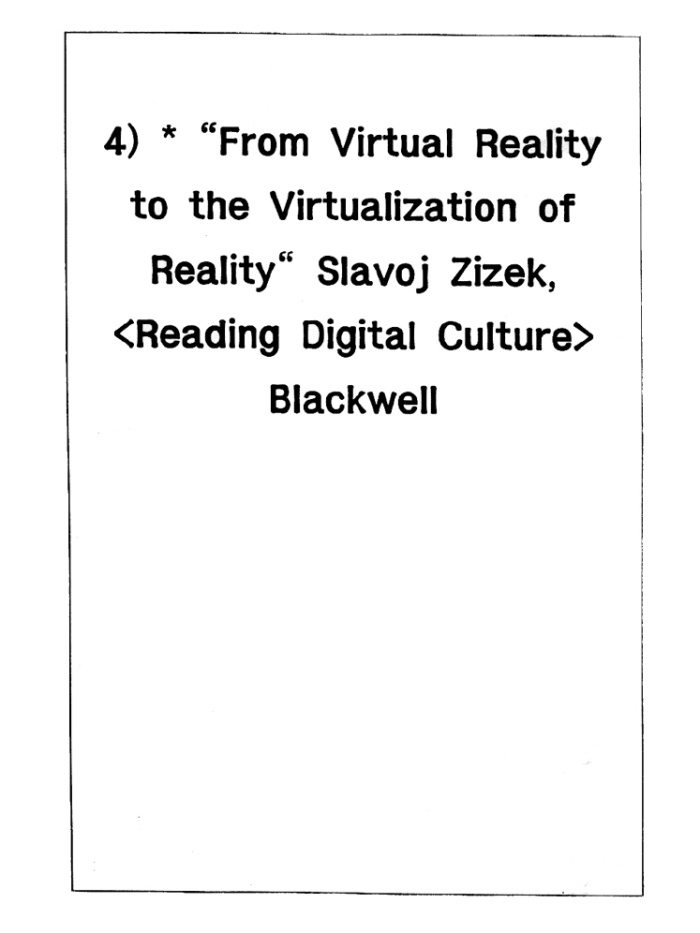
Slavoj Žižek, „From Virtual Reality to Virtualization of Reality” [w:] Electronic Culture: Technology and Visual Representation, red. T. Druckrey, Aperture Foundation, 1996, s. 290–295. Źródło.
When in 2001, Zygmunt Bauman writes that in the individualized society, “the added value of ‘joining forces’ (...) is difficult to spot,”31 it seemed he wasn’t aware of the then-new collaborative practices of amateurs creating content (e.g. Wikipedia) and tools (open source), but Máslo might have actually proven his point as the driving force behind their action was apolitical decadence (their word) more than anything else – decadence being deemed as something “cool.” Máslo embodied the aesthetic potential akin to the happenings with their playfulness rather than the politics of the Situationists. Because while Situationists tried to wake people up and break away from the Spectacle, its post-90s reincarnation – Máslo – was seen as inescapable, and could have been bested only by its affirmation, i.e. by exploiting its own resources against it while making it all the easier for capitalism to adopt these tactics soon after that. The ebb and flow of exploration and experimentation almost never manage to establish themselves as the new norm at the same time as they herald, if not outright usher in, the coming modification of something old. Because although Rheingold might have guessed correctly when he wrote in Smart Mobs that “The ‘killer apps’ of tomorrow’s mobile infocom industry won’t be hardware devices or software programs but social practices.”32 this does in no way preclude these new social practices being immediately recuperated in the form of Groupons and crowdsourcing campaigns or malevolent crowds indexically organized around hashtags on Twitter and elsewhere for the sake of doxxing or trolling.
The members of Máslo today admit that as the internet skyrocketed they themselves were taken aback. And even though not long after that they disappeared in the folds of the network culture becoming social media marketing experts, programmers, data journalists and, generally, media experts, the short-lived but inspiring adventures of Máslo’s affirmative fight with reality shall mark a historical prelude to its current normalization.
BIO
Palo Fabuš is a critic and theorist. He studied applied informatics, media studies, sociology, and philosophy. He was curator of Brno Zoom festival in 2005 and 2006, worked as an editor of Literární noviny between 2005–2008 and co-founded Jlbjlt.org in 2007. He taught at the Department of Media Studies and Journalism at Masaryk University in Brno and has given guest lectures at most of the Czech and Slovak art schools. Since 2009, he is an editor of Umělec magazine and since 2011 he has been editor-in-chief. Currently, he teaches at the Centre of Audiovisual Studies, FAMU in Prague, and in the MA Fine Art programme at Prague College. His writings were published by the Slovak and Czech print and online media. In 2017, he published a book “Přednáška o vznikavosti” together with poet Luboš Svoboda. His interest in new media has evolved into research of wider contemporary culture from the perspective of sociology and philosophy of media and technology. His research centers these days mostly on the relationship of digital ecology and the human condition. https://palofabus.net/
* Cover photo: Máslo hackuje realitu, http://maslo.cz/denik.mml
[1] Watts, Duncan J. 2003. Six Degrees: The Science of a Connected Age, W. W. Norton, p. 307.
[2] Prague reportedly saw some 60–100 participants, while Brno saw around 30.
[3] Like the amateur literary server pismak.cz, the internet-related news outlets underground.cz and root.cz, pre-meme Photoshop humor website kompost.cz and Slovak discussion board kyberia.sk.
[4] “Butter... that's what we call the ungraspable reality that means nothing and everything at the same time… Why do people feel that something is not as it should be? Why are there so many bad things everywhere? Why do a thousand good individuals create a monstrous crowd? Why is humanity slipping in so many ways? Butter. That's the answer.”
[6] As embodied by Web 2.0 ideology and reflected by Vin Crosbie in “What Is New Media?“ (2002)
[7] Volek, Jaromír. 2002. "Nezamýšlené důsledky "komunikační ideologie" v kontextu informační společnosti" Pp. 11–38 in Média a realita: sborník prací Katedry mediálních studií a žurnalistiky, Brno: Masarykova Universita v Brně.
[8] This impression, I believe, contributed also to the ideological charge of “open source” as a technological opposition to the corporate hegemony.
[9] https://web.archive.org/web/20021022091704/http://www.maslo.cz/denik.mml
[10] https://web.archive.org/web/20040610121001/http://www.maslo.cz/intro.mml
[11] The proof of which I present with a sense of mild embarrassment in the form of the student magazine (in Czech) I published during my time at university: https://www.fi.muni.cz/informagika/archive/im0502.pdf
[12] https://web.archive.org/web/20020805030157/http://www.maslo.cz/fakta.mml
[13] Although as you can see from the original numbering, Máslo considered it to be the zeroth: http://maslo.cz/hack00
[14] https://cs.wikipedia.org/wiki/Binary.division
[15] https://web.archive.org/web/20021008074945/http://www.maslo.cz/news/001.html
[16] https://hell.sk/2001/09/06/digital/
[17] The modern trailblazers being of course Tony Blair, whose innovation was bringing his PR publicist to his meetings, and, of course, Geoerge Bush’s administration that famously distanced itself from the “reality-based community.”
[19] https://maslo.cz/rozhlas2
[21] Rheingold, Howard. 2002. Smart Mobs: The Next Social Revolution. Basic books, p. xii.
[24] http://www.smartmobs.com/2003/07/29/flash-mobs-roundup/
[25] “The goal of a flash mob is the gathering of crowds. The goal of reality hack is the disruption of a stereotype.”
[26] https://web.archive.org/web/20040824045951/http://www.maslo.cz/texty/673.html
[27] https://web.archive.org/web/20040413034914/http://www.maslo.cz/denik/200309.html
[28] http://content.time.com/time/magazine/article/0,9171,474568,00.html
[29] Žižek, Slavoj. 1996. “From Virtual Reality to Virtualization of Reality” Pp. 290–295 in Druckrey, T. (ed., Electronic Culture: Technology and Visual Representation. Canada and U. K., Aperture Foundation, p. 293.
[30] https://web.archive.org/web/20030820144715/www.dashes.com/anil/index.php?archives/006972.php
[31] Individualized Society. Polity, 2001, p. 9
[32] Rheingold, Howard. Smart Mobs, op. cit., p. xii.



